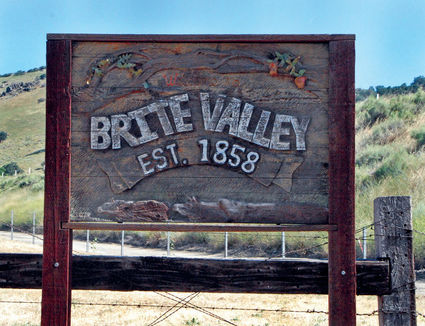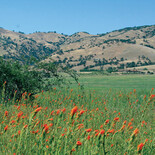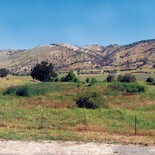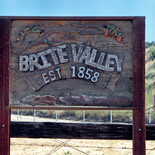Brite Valley: a small jewel of a location in the Tehachapi Mountains
Land of Four Seasons
July 20, 2019
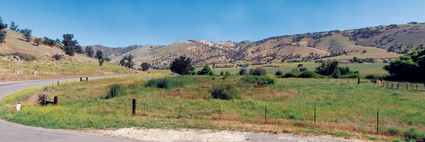
Jon Hammond
This meadow location at Brite's Corner was once the site of the Brite family's original adobe home, built in 1859.
There are four main valleys in the Tehachapi Mountains: Tehachapi, Brite, Cummings and Bear Valleys. Each of them are similar, basin-like valleys entirely ringed by mountains, but each of them have their own characteristics.
Brite Valley is the smallest of the four, and is approximately four miles long by two miles wide. It is a diverse and charming little valley with a long history.
The first permanent residents of Brite Valley are believed to be Nuwä (Kawaiisu or Paiute) people whose occupation dates back thousands of years. They gathered plant resources like acorns, bulbs, seeds and fresh greens, and hunted deer, rabbits, quail and other animals.
There are still lots of pahaz (pronounced pah-haz) or grinding holes in bedrock throughout Brite Valley that remain from many hundreds of years of Native American presence. Indian Hill Ranch, at the highest portion of Brite Valley up at the southern end, was named for the pahaz found on a hilltop at the ranch, which is owned by the Schultz family.
There is also a unique cluster of these grinding holes at a milling site in a massive marble outcropping on the Spring Oaks Ranch, which is located behind the J.C. Jacobsen Reservoir, also known as Brite Lake. These pahaz in marble are highly unusual, with most mortar holes found in granite, tonalite, sandstone and other types of bedrock. This marble deposit was later quarried in the 1870s for building materials.
The natural qualities that made Brite Valley appealing to Native people – good water, game, lots of oak trees, a sheltered location from prevailing winds – also attracted the first white settlers to the area, and Brite Valley was the site of some of the earliest permanent homesteads in the Tehachapi Mountains.
Study the history of an area and you'll typically find that the people who arrived first picked some of the choicest locations to live. This is true of Brite Valley which, in addition to the qualities that attracted Indian people, also has areas of rich soil, which appealed to farmers and ranchers.
John Moore Brite, his wife Amanda and their children were the earliest settlers, and it is for them that the valley was named. The Brites came from Texas and originally built a log house in the western part of the Tehachapi Valley in 1854, and then in 1858 moved to Brite Valley and built an adobe home there in 1859.
The early residents of Brite Valley were mostly members of the Brite and Wiggins families. Amanda Brite had 13 children, 10 of whom lived into adulthood, and many of them stayed in the area and some intermarried with members of the Wiggins family – there was once a local baseball team made up entirely of brothers and cousins from the Brite and Wiggins families.
In the late 1880s, after his children were all raised, John Brite built a new house across the road from the old adobe. After John Brite's death, it was owned by his son Charles Richard, who was known as Dick Brite, and for many years it was known to locals as the Dick Brite house. For much of the past 75 years it was owned by Mr. and Mrs. Pelliser, and with their passing it became the property of their nephew, Jean Prel. Local kids long referred to it as "the haunted house," though it has always been occupied and is not known for any ghostly activity.
As decades passed, Brite Valley continued to be home to scattered farms, ranches and homes. There are three main roads in Brite Valley: Cummings Valley Road, Banducci Road and Arosa Road.
Cummings Valley Road is the oldest, and sounds misnamed, since it is in Brite Valley, but is named Cummings Valley Road because it leads to Cummings Valley. This road passes through the lower, earliest settled portion of Brite Valley. Banducci Road starts at the eastern edge of Brite Valley, connecting to Highline Road, and it too meanders through Brite Valley and travels to Cummings Valley. Arosa Road runs north/south to the highest, southern portion of Brite Valley and is one of two entrances to the Alpine Forest Park housing development. Many of the newer homes in Brite Valley are accessed by Arosa Road.
A defining feature of Brite Valley was added in 1971 with the creation of a dam and reservoir to store some of the 20,000 acre-feet of State Project Water that the Tehachapi-Cummings County Water District receives from the Kern County Water Agency. The lake began to fill up on Nov. 14, 1973, and it has been a blue gem in the middle of Brite Valley ever since.
The Brite Lake Aquatic Recreation Area is administered by the Tehachapi Valley Recreation and Parks District, and offers year-round camping, fishing and boating. The lake attracts waterfowl and shorebirds, and is a good place for year-round birding as well.
Recent years have seen a resurgence of agriculture in Brite Valley, primarily the growing of organic salad greens in the fertile dark alluvial soil of lower Brite Valley. There are also many small ranches and horse properties. The Cook Tract, directly east of Brite Lake, is a pleasant neighborhood of homesteads and small farms.
Jay and Hannah Shipman recently started Brite Creek Farms, right where Brite Valley and Tehachapi Valley meet, and their welcoming farm stand offers an array of local organic farm products. Nearby is the Jadric family's J Ranch, which includes a nursery open to the public with trees and shrubs.
Brite Valley is a beautiful, diverse and picturesque part of the Tehachapi Mountains. It has been valued by people from the Nuwä to the current residents, and it is an enjoyable place to live or to visit.
Jon Hammond is a fourth generation Kern County resident who has photographed and written about the Tehachapi Mountains for 38 years. He lives on a farm his family started in 1921, and is a speaker of Nuwä, the Tehachapi Indian language.





